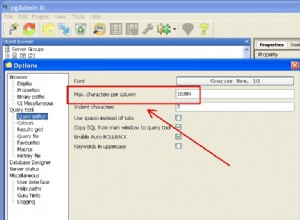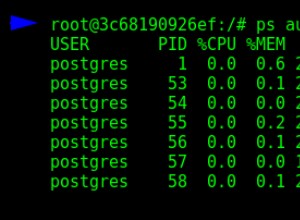Dieser Artikel listet den SQL INSERT auf Syntax, wie sie von verschiedenen Datenbankverwaltungssystemen (DBMSs) implementiert wird. Die Syntax wird genau so aufgeführt, wie sie jeder Anbieter auf seiner Website aufgeführt hat. Klicken Sie auf den entsprechenden Link, um weitere Einzelheiten zur Syntax für einen bestimmten Anbieter anzuzeigen.
Die behandelten DBMS sind MySQL, SQL Server, PostgreSQL und Oracle Database.
MySQL
Aus dem MySQL 5.7 Referenzhandbuch:
INSERT [LOW_PRIORITY | DELAYED | HIGH_PRIORITY] [IGNORE]
[INTO] tbl_name
[PARTITION (partition_name,...)]
[(col_name,...)]
{VALUES | VALUE} ({expr | DEFAULT},...),(...),...
[ ON DUPLICATE KEY UPDATE
col_name=expr
[, col_name=expr] ... ] Oder:
INSERT [LOW_PRIORITY | DELAYED | HIGH_PRIORITY] [IGNORE]
[INTO] tbl_name
[PARTITION (partition_name,...)]
SET col_name={expr | DEFAULT}, ...
[ ON DUPLICATE KEY UPDATE
col_name=expr
[, col_name=expr] ... ] Oder:
INSERT [LOW_PRIORITY | HIGH_PRIORITY] [IGNORE]
[INTO] tbl_name
[PARTITION (partition_name,...)]
[(col_name,...)]
SELECT ...
[ ON DUPLICATE KEY UPDATE
col_name=expr
[, col_name=expr] ... ] SQL-Server
Aus der Transact-SQL-Referenz:
[ WITH <common_table_expression> [ ,...n ] ]
INSERT
{
[ TOP ( expression ) [ PERCENT ] ]
[ INTO ]
{ <object> | rowset_function_limited
[ WITH ( <Table_Hint_Limited> [ ...n ] ) ]
}
{
[ ( column_list ) ]
[ <OUTPUT Clause> ]
{ VALUES ( { DEFAULT | NULL | expression } [ ,...n ] ) [ ,...n ]
| derived_table
| execute_statement
| <dml_table_source>
| DEFAULT VALUES
}
}
}
[;]
<object> ::=
{
[ server_name . database_name . schema_name .
| database_name .[ schema_name ] .
| schema_name .
]
table_or_view_name
}
<dml_table_source> ::=
SELECT <select_list>
FROM ( <dml_statement_with_output_clause> )
[AS] table_alias [ ( column_alias [ ,...n ] ) ]
[ WHERE <search_condition> ]
[ OPTION ( <query_hint> [ ,...n ] ) ]
<column_definition> ::=
column_name <data_type>
[ COLLATE collation_name ]
[ NULL | NOT NULL ]
<data type> ::=
[ type_schema_name . ] type_name
[ ( precision [ , scale ] | max ]
-- External tool only syntax
INSERT
{
[BULK]
[ database_name . [ schema_name ] . | schema_name . ]
[ table_name | view_name ]
( <column_definition> )
[ WITH (
[ [ , ] CHECK_CONSTRAINTS ]
[ [ , ] FIRE_TRIGGERS ]
[ [ , ] KEEP_NULLS ]
[ [ , ] KILOBYTES_PER_BATCH = kilobytes_per_batch ]
[ [ , ] ROWS_PER_BATCH = rows_per_batch ]
[ [ , ] ORDER ( { column [ ASC | DESC ] } [ ,...n ] ) ]
[ [ , ] TABLOCK ]
) ]
}
[; ] PostgreSQL
Aus dem PostgreSQL 9.5-Handbuch:
[ WITH [ RECURSIVE ] with_query [, ...] ]
INSERT INTO table_name [ AS alias ] [ ( column_name [, ...] ) ]
{ DEFAULT VALUES | VALUES ( { expression | DEFAULT } [, ...] ) [, ...] | query }
[ ON CONFLICT [ conflict_target ] conflict_action ]
[ RETURNING * | output_expression [ [ AS ] output_name ] [, ...] ]
where conflict_target can be one of:
( { index_column_name | ( index_expression ) } [ COLLATE collation ] [ opclass ] [, ...] ) [ WHERE index_predicate ]
ON CONSTRAINT constraint_name
and conflict_action is one of:
DO NOTHING
DO UPDATE SET { column_name = { expression | DEFAULT } |
( column_name [, ...] ) = ( { expression | DEFAULT } [, ...] ) |
( column_name [, ...] ) = ( sub-SELECT )
} [, ...]
[ WHERE condition ] Oracle-Datenbank
Aus der Oracle Database Online Documentation 12c Version 1 (12.1):
INSERT [ hint ]
{ single_table_insert | multi_table_insert } ; Unten finden Sie eine Beschreibung der Klauseln und ihrer untergeordneten Klauseln.
single_table_insert ::=
insert_into_clause
{ values_clause [ returning_clause ]
| subquery
} [ error_logging_clause ] insert_into_clause ::=
INTO dml_table_expression_clause [ t_alias ] [ (column [, column ]...) ]
values_clause ::=
VALUES ({ expr | DEFAULT }
[, { expr | DEFAULT } ]...
) returning_clause::=
{ RETURN | RETURNING } expr [, expr ]...
INTO data_item [, data_item ]... multi_table_insert ::=
{ ALL
{ insert_into_clause [ values_clause ] [error_logging_clause] }...
| conditional_insert_clause
} subquery conditional_insert_clause ::=
[ ALL | FIRST ]
WHEN condition
THEN insert_into_clause
[ values_clause ]
[ error_logging_clause ]
[ insert_into_clause [ values_clause ] [ error_logging_clause ] ]...
[ WHEN condition
THEN insert_into_clause
[ values_clause ]
[ error_logging_clause ]
[ insert_into_clause [ values_clause ] [ error_logging_clause ] ]...
]...
[ ELSE insert_into_clause
[ values_clause ]
[ error_logging_clause ]
[ insert_into_clause [ values_clause ] [ error_logging_clause ] ]...
] DML_table_expression_clause::=
{ [ schema. ]
{ table
[ partition_extension_clause
| @ dblink
]
| { view | materialized view } [ @ dblink ]
}
| ( subquery [ subquery_restriction_clause ] )
| table_collection_expression
} partition_extension_clause::=
{ PARTITION (partition)
| PARTITION FOR (partition_key_value [, partition_key_value]...)
| SUBPARTITION (subpartition)
| SUBPARTITION FOR (subpartition_key_value [, subpartition_key_value]...)
} subquery_restriction_clause::=
WITH { READ ONLY
| CHECK OPTION
} [ CONSTRAINT constraint ] table_collection_expression ::=
TABLE (collection_expression) [ (+) ]
error_logging_clause ::=
LOG ERRORS
[ INTO [schema.] table ]
[ (simple_expression) ]
[ REJECT LIMIT { integer | UNLIMITED } ] Über das INSERT Erklärung
Das INSERT -Anweisung fügt neue Zeilen in eine Tabelle ein. Sie können eine oder mehrere Zeilen einfügen, die durch Wertausdrücke angegeben sind, oder null oder mehrere Zeilen, die aus einer Abfrage resultieren.




